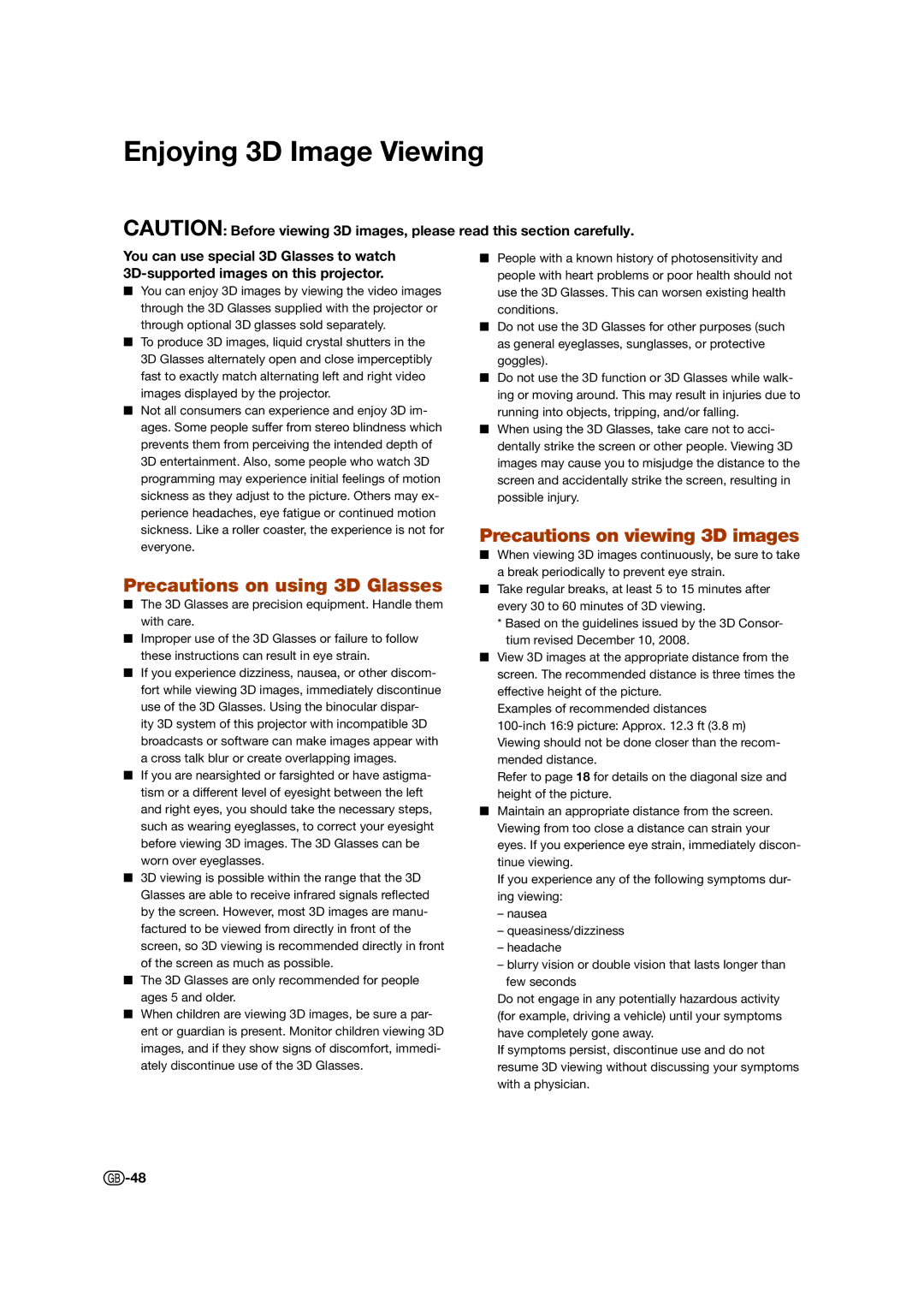
Enjoying 3D Image Viewing
CAUTION: Before viewing 3D images, please read this section carefully.
You can use special 3D Glasses to watch
You can enjoy 3D images by viewing the video images through the 3D Glasses supplied with the projector or through optional 3D glasses sold separately.
To produce 3D images, liquid crystal shutters in the
3D Glasses alternately open and close imperceptibly fast to exactly match alternating left and right video images displayed by the projector.
Not all consumers can experience and enjoy 3D im- ages. Some people suffer from stereo blindness which prevents them from perceiving the intended depth of 3D entertainment. Also, some people who watch 3D programming may experience initial feelings of motion sickness as they adjust to the picture. Others may ex- perience headaches, eye fatigue or continued motion sickness. Like a roller coaster, the experience is not for everyone.
Precautions on using 3D Glasses
The 3D Glasses are precision equipment. Handle them with care.
Improper use of the 3D Glasses or failure to follow these instructions can result in eye strain.
If you experience dizziness, nausea, or other discom- fort while viewing 3D images, immediately discontinue use of the 3D Glasses. Using the binocular dispar- ity 3D system of this projector with incompatible 3D broadcasts or software can make images appear with a cross talk blur or create overlapping images.
If you are nearsighted or farsighted or have astigma- tism or a different level of eyesight between the left and right eyes, you should take the necessary steps, such as wearing eyeglasses, to correct your eyesight before viewing 3D images. The 3D Glasses can be worn over eyeglasses.
3D viewing is possible within the range that the 3D Glasses are able to receive infrared signals reflected by the screen. However, most 3D images are manu- factured to be viewed from directly in front of the screen, so 3D viewing is recommended directly in front of the screen as much as possible.
The 3D Glasses are only recommended for people ages 5 and older.
When children are viewing 3D images, be sure a par- ent or guardian is present. Monitor children viewing 3D images, and if they show signs of discomfort, immedi- ately discontinue use of the 3D Glasses.
People with a known history of photosensitivity and people with heart problems or poor health should not use the 3D Glasses. This can worsen existing health conditions.
Do not use the 3D Glasses for other purposes (such as general eyeglasses, sunglasses, or protective goggles).
Do not use the 3D function or 3D Glasses while walk- ing or moving around. This may result in injuries due to running into objects, tripping, and/or falling.
When using the 3D Glasses, take care not to acci- dentally strike the screen or other people. Viewing 3D images may cause you to misjudge the distance to the screen and accidentally strike the screen, resulting in possible injury.
Precautions on viewing 3D images
When viewing 3D images continuously, be sure to take a break periodically to prevent eye strain.
Take regular breaks, at least 5 to 15 minutes after every 30 to 60 minutes of 3D viewing.
*Based on the guidelines issued by the 3D Consor- tium revised December 10, 2008.
View 3D images at the appropriate distance from the screen. The recommended distance is three times the effective height of the picture.
Examples of recommended distances
Refer to page 18 for details on the diagonal size and height of the picture.
Maintain an appropriate distance from the screen. Viewing from too close a distance can strain your eyes. If you experience eye strain, immediately discon- tinue viewing.
If you experience any of the following symptoms dur- ing viewing:
– nausea
– queasiness/dizziness
– headache
– blurry vision or double vision that lasts longer than few seconds
Do not engage in any potentially hazardous activity (for example, driving a vehicle) until your symptoms have completely gone away.
If symptoms persist, discontinue use and do not resume 3D viewing without discussing your symptoms with a physician.
![]() -48
-48
